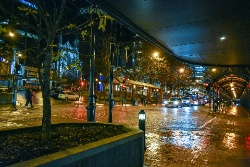New Process Considered For Extensive Urban Development In Tauranga
In response to the significant housing need in Tauranga and a request by Tauranga City Council, the Government’s urban development agency, Kāinga Ora – Homes and Communities, has selected Tauranga’s Western Corridor as the second project for assessment as a potential Specified Development Project (SDP) under the Urban Development Act 2020.
Selection for assessment kicks off an extensive engagement and consultation process, as Kāinga Ora considers the suitability of using its urban development tools for the project area. Once the assessment process is complete, Kāinga Ora will recommend to Ministers whether or not an SDP should be established.
The western Bay of Plenty sub-region, which includes Tauranga City, has been one of New Zealand’s fastest growing urban areas in recent years. As the population has increased, the demand for housing has exceeded supply, pushing up property prices and increasing the need for new urban development areas.
The SmartGrowth Partnership[1], which includes the local and regional Councils, tangata whenua and central Government, estimates that an additional 43,000 homes are needed in the region by 2048.
The SmartGrowth partners have identified the Western Corridor as key to meeting this demand and have been looking at how this area can be unlocked for development. Tauranga City Council has now formally requested that Kāinga Ora consider the Western Corridor for selection as a potential SDP under the Urban Development Act 2020.
Tauranga City Council Commissioner, Stephen Selwood, says despite the Western Corridor being identified for urban development through SmartGrowth, the Council has found it difficult to make substantive progress to enable development in the area.
“The size and scale of the planned growth, necessary investment in infrastructure and complexity of structure planning and rezoning under the Resource Management Act 1991 (RMA) has slowed development in the Western Corridor,” he says.
“Tauranga has a significant housing gap and is the only metropolitan area in New Zealand which cannot comply with the housing supply requirements set-out in the Government’s National Policy Statement on Urban Development. The latest projections show that over the next 10 years, the city will be between 7,000 and 9,000 homes short of the number the city needs.
“To deliver housing and urban development at the pace and scale required to meet the needs of our community, it is critical that the planning, infrastructure and funding for urban development are agreed upfront, providing greater certainty and coordination for implementation and delivery.
"A Specified Development Project would provide a process to deliver that integrated planning in the short term, while still allowing the opportunity to future proof the Western Corridor for envisaged growth over the medium and long term."
The proposed project area under assessment includes Tauriko West, Keenan Road and Tauriko Business Estate’s Lower Belk Road extension – three existing urban growth areas which are at various stages of planning and development. Proposals for the wider area include development of new housing and employment areas, an improved transport network, community facilities (including schools) and amenities such as green spaces.
Kāinga Ora General Manager Urban Planning and Design, Katja Lietz, says initial considerations suggest that the Western Corridor could benefit from Kāinga Ora using its urban development tools to facilitate development in the area.
“Specified Development Projects can provide a way for Kāinga Ora to enable transformational, complex urban development,” she says.
“The Western Corridor presents a significant opportunity for the SmartGrowth Partnership, tangata whenua, private developers and landowners to work together to deliver a sustainable, inclusive and thriving community for the people of Tauranga. If established, an SDP can facilitate further collaboration, bringing together a clear development plan aligning land-use planning, infrastructure planning and funding.
“This is one of the fastest-growing regions in the country and our focus during the assessment process will be to determine whether these new urban development tools are the right ones to support a well-planned, high-quality urban development that meets the needs of the community.”
About Kāinga Ora
Kāinga Ora - Homes and Communities is a crown entity established under the Kāinga Ora - Homes and Communities Act 2019. As the NZ Government’s housing agency, Kāinga Ora has two key roles:
· To be a world-class public housing landlord
· To partner with the development community, Māori, local and central government, and others on urban development projects of all sizes.
Kāinga Ora is responsible for facilitating key aspects of the Urban Development Act 2020, supporting urban development, and leading and promoting good urban design. We are focused on increasing housing supply whilst delivering quality urban spaces, connecting homes with jobs, transport, open spaces and the facilities communities need. Building better, brighter homes, communities and lives.
About Tauranga and the Western Corridor development
Tauranga and the western Bay of Plenty is one of New Zealand’s fastest-growing areas, forecast to grow to a population of nearly 250,000 by 2048. This means around 43,000 more homes would be needed with around 80 percent of that growth being within Tauranga City.
The Western Corridor has been identified by the SmartGrowth Partnership as a key corridor for housing and urban development to support the growth of the city over the next 50 years.
The proposed project area under assessment includes the planned urban growth areas of Tauriko West, Keenan Road and Tauriko Business Estate’s Lower Belk Road extension. The recently adopted Urban Form and Transport Initiative (UFTI) Connected Centres Programme[2] confirmed these areas as priority development areas for the city.
The development of the Western Corridor has the potential to contribute to addressing demand for housing and business land in an integrated manner across the western Bay of Plenty sub-region, as well as providing green space and recreational areas, and improving protection of, and connection to, the Wairoa River.
About the Urban Development Act and Specified Development Projects
The Urban Development Act 2020 (UDA) empowers Kāinga Ora to undertake and facilitate transformational, complex urban development contributing to sustainable, inclusive and thriving communities. Specified Development Projects (SDPs) can be established under the Act, and provide a new way for Kāinga Ora to work with councils, iwi and private developers to plan and deliver transformational, complex urban developments.
Through the SDP process Kāinga Ora can assist significant development projects that have historically struggled to progress due to complexities such as multiple landowners needing to work together, or infrastructure delivery. Kāinga Ora can bring all parties together to create a development plan and use its powers under the UDA to help deliver on the plan.
The benefits of establishing an SDP are:
• A way for multiple parties to collaborate and access urban development tools
• Greater certainty of outcome given the ability to establish clear objectives and a project governance group with clear mandate to facilitate the project
• Long term collaboration for the life of the project
• Greater control and coordination of all development in an area in the collective interest of all parties
• Alternative plan change process which enables a comprehensive and integrated development plan
• Funding plan could be used to lock down and co-ordinate all public funding of a project including commitment of longer term funding
• Efficiencies of infrastructure delivery and construction
Central to the process is a collaborative partnership approach, front-loading conversations between project partners and engaging with local community and stakeholders early on.
Timeframes for the assessment process will depend on many factors including engagement with partners and stakeholders.
As part of its assessment process, Kāinga Ora works with project partners to design an extensive stakeholder engagement and consultation process specific to the project. This involves key workshops with stakeholders, public notification and opportunities for feedback. The process will be conveyed to partners, stakeholders and the community shortly after selection.
The SDP assessment process leads to a decision as to whether Kāinga Ora recommends to the responsible Ministers that an SDP be established for the proposed project. It is then up to the responsible Ministers to decide whether to accept the recommendation.
Read more about Specified Development Projects at www.kaingaora.govt.nz/sdp.
[1] The Smart Growth Partnership is a collaboration between Tauranga City Council, Western Bay of Plenty District Council, Bay of Plenty Regional Council and tangata whenua working with central Government, businesses, education groups, industry and the community.
[2] UFTI is a collaborative project led by SmartGrowth and Waka Kotahi and involves Western Bay of Plenty District Council, Tauranga City Council, Bay of Plenty Regional Council, central government (including Ministry of Housing and Urban Development, and Kāinga Ora), iwi, and the community.


 Gordon Campbell: On Miserly School Lunches, And The Banning Of TikTok’s Gaza Coverage
Gordon Campbell: On Miserly School Lunches, And The Banning Of TikTok’s Gaza Coverage Green Party: Greens Welcome Cross-party Approach To Climate Adaptation
Green Party: Greens Welcome Cross-party Approach To Climate Adaptation Government: Climate Change – Mitigating The Risks And Costs
Government: Climate Change – Mitigating The Risks And Costs Greenpeace: Protest March Against Fast-track Bill Announced For Auckland
Greenpeace: Protest March Against Fast-track Bill Announced For Auckland Wellington Office of the Mayor: Mayor Responds To Housing Minister’s District Plan Decision
Wellington Office of the Mayor: Mayor Responds To Housing Minister’s District Plan Decision Stats NZ: Have Your Say On Modernising The Census
Stats NZ: Have Your Say On Modernising The Census NZ Government: Therapeutic Products Act To Be Repealed
NZ Government: Therapeutic Products Act To Be Repealed


